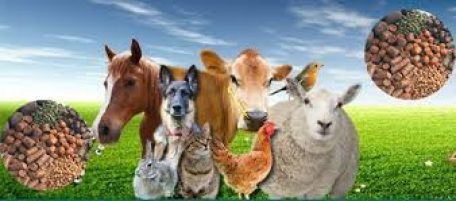The cassava tuberous root is primarily a source of carbohydrate and can completely replace maize as an energy source in feeds for pigs and poultry. Its use for this purpose is presently limited to research centres and small-scale pig producers. For adoption by large scale commercial producers, appropriate technology needs to be developed to reduce the high moisture and hydrocyanic acid (HCN) contents of the tubers. Properly dried whole cassava tuberous roots can replace maize in nonruminant rations if the HCN does not exceed 100 ppm in finished feeds. Since cassava is low in protein, it is necessary to supplement cassava-based diets with animal proteins for the supply of methionine and lysine. Supplementation with a zinc salt prevents parakeratosis. Addition of oil and/or pelletizing is desirable. The cost of cassava-based rations can be reduced by incorporating cassava leaves to enhance its protein contribution. Cassava peelings can also be satisfactorily used up to 40 percent for pigs, 15 percent for broilers and 27 percent for layers. The envisaged reduction in cost per ton of finished cassava-based feeds will result in the production of cheaper animal products in Africa.
Africa is currently plagued with a food crisis, due partly to the unprecedented rise in human population and the alarming drop in per capita food production particularly in the last decade (FAO 1986). The food deficit situation is indeed more serious with protein deficiency when compared to the availability of calories and the micro elements. Shortage of proteins, particularly those of animal origin, is prevalent in all parts of Africa where it is estimated that on the average, 10g of animal protein is consumed per day, compared to a recommended daily intake of 35g (ILCA 1980, FAO 1986). Poultry and pig production represent the fastest means of correcting the shortage of animal proteins in Africa. This is because, apart from their high rate of reproduction, poultry and pigs are characterized by the best efficiency of nutrient transformation into high quality animal protein, although the cost of this transformation is very high. Therefore, nutrient supply has to be judiciously manipulated to ensure the production of meat at economical rates.
Energy source constitutes between 45 and 60 percent of finished feeds for monogastric animals, and at present, corn constitutes the bulk of the energy source used in compounding concentrate rations. Other grains which are used to a lesser extent include sorghum, millet, wheat, barley, oats, cassava chips, and molasses. The difficulty of obtaining foreign exchange in many African countries has considerably reduced the imports of corn and other cereals. At the same time, local production of cereal grains remains grossly inadequate for direct human consumption, livestock feed, and for other industries. These shortages have therefore resulted in astronomical increases in the price of grains in recent times. In Nigeria, for example, prices of maize increased from  800 per ton to about
800 per ton to about  1 500 per ton between 1987 and 1988. This has adversely affected the cost of production of pigs and poultry which depend almost entirely on concentrate feeds. It is therefore necessary to investigate locally available alternative of energy for commercial pig and poultry enterprise in Africa.
1 500 per ton between 1987 and 1988. This has adversely affected the cost of production of pigs and poultry which depend almost entirely on concentrate feeds. It is therefore necessary to investigate locally available alternative of energy for commercial pig and poultry enterprise in Africa.
Agronomic and nutritional potentials of cassava
Cassava is a mayor staple food widely cultivated in the lowland humid tropics. Cassava is capable of providing very high yields of energy/ha, for example, about 13 times more than maize or guinea corn (Oke 1978). Out of the estimated 125 million tons of cassava produced yearly (Phillips 1983), about 90 percent is used as human food while the remainder is used largely as animal feed and for other industrial products. The average yield of cassava in traditionally cultivated varieties is 6.4 tons/ha which is too low to sustain demands for human consumption and for industrial use. However, through the efforts of the IITA in Ibadan, varieties have been developed that could yield 15-20 tons/ha which is several times the average local yield under local agricultural systems. It will therefore appear that the high agronomic potential of cassava can be fully exploited to drastically increase production and thus provide enough cassava for use in feeding livestock without adversely affecting the needs for human consumption.
While the use of cassava for livestock feeding has been advocated by many researchers, its nutritional characteristics require a careful balancing for nutrients in which it is deficient, in order to ensure the satisfactory performance of livestock and cost-effectiveness.
The cassava tuberous root is essentially a carbohydrate source. It contains very little protein which is of poor quality. Cassava also contains the cyanogenic glucosides, linamarin and lotaustralin, which on hydrolysis yield hydrocyanic acid that is toxic to animals. In small doses cyanide is detoxified to thiocyanate, a goitrogen, by means of the enzyme rhodanase, making use of methionine as the sulfur donor. This amino acid therefore becomes a limiting factor in cassava feeds.
Nevertheless, cassava and its by-products can be profitably used in the feeding of monogastric animals if its nutrient composition is considered in the formulation of balanced rations that will guarantee the satisfactory productivity of stock
Utilization of cassava in poultry feeding
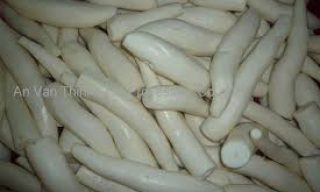
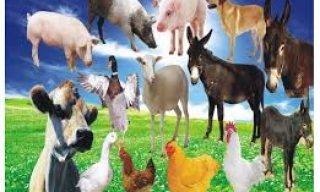
Poultry feed constitutes more than 90 percent of au commercial rations produced by feed millers in Nigeria. The use of cassava as a substitute for maize will therefore make its greatest impact if it can be incorporated into commercial poultry feeds.
Studies conducted with cassava flour on poultry give conflicting results, particularly with young chickens. Satisfactory growth response has been obtained for growing chicks on inclusion of about 10 percent cassava flour in chick ration in most of the reported trials (table 1). Higher levels of inclusion of up to 50 percent have also given favorable responses in a few instances. A 40 percent inclusion of cassava flour in layers’ rations has been found to be satisfactory for egg production.
Table 1. Summary of performance of poultry on cassava flour based rations
|
Class of chicken |
% cassava replacement of maize in diet |
Performance |
Reference |
| Chicks | 0.6 | Satisfactory growth | Tabayoyong (1935) |
| Chicks | 0-5 | Satisfactory growth at all levels of inclusion | Tejada and Brambila (1969) |
| Chicks | 10 | Satisfactory growth | Klein and Barlowen (1954) |
| Chicks | 0-50 | Satisfactory growth at 10% inclusion | Job et al. (1980) |
| Growers | 0-25 | Satisfactory growth at 5% inclusion | Job et al. (1980) |
| Layers | 0-40 | Satisfactory egg production | Temperton and Dudley (1941) |
| Layers | 50-60 | Satisfactory egg production | Pillai et al. (1968); Enriquez and Ross(1972); Hamid and Jalaludin (1972) |
Note: Chicks are 0-12 weeks
In the European Economic Community (EEC), a maximum of 20 percent inclusion of cassava in poultry rations has been fixed for satisfactory poultry production. The reasons given for limiting the use of cassava flour or chips in poultry rations include the dustiness of the feedstuff which causes irritation of the respiratory tract of the chickens unless the feed is pelletized or some oil is added. Pelletizing is also recommended as powdered starch has been reported to produce ulcerogenic effects in the gastric mucosa (Oke 1978). Dustiness of cassava feedstuff can reduce intake in poultry which adversely affects productivity.
The level of hydrocyanic acid (HCN) in cassava limits the use of cassava and its products for livestock feeding. Drying considerably reduces the HCN level and sun-drying has been demonstrated to be more effective than oven-drying (Tewe et al. 1980). Where the HCN is below 100 ppm, as in cassava flour or chips, cassava can be safely incorporated into rations as is allowed in the EEC (Derange end Ahluwalia 1983). It is however important to note that when cassava chips are sun-dried on the floor, they could be infected by microorganisms such as Aspergillus niger. This can predispose young chicks in particular to diseases such as aflatoxicosis and even increase mortality. The presence of microorganisms demands the use of antibiotics in dried cassava rations. In this regard, the drying of cassava chips particularly during the rainy season can pose serious problems of microbial infestation and these could be more serious than the hydrocyanic acid in dried cassava samples.
The presence of hydrocyanic acid calls for additional supplementation of cassava-based diets with methionine either in its pure form or as animal protein supplements, particularly fish meal. Lysine supplementation is also suggested for maximum efficiency (Oke 1978).
Cassava wastes constitute the major by-products of tubers used for preparing human foods and industrial starch. The mechanization of gari production in Nigeria has resulted in large quantities of peel and wasted small-sized tubers which are difficult to process, and are therefore discarded. Cassava peel accounts for between 10 and 13 percent of the tuber weight (Tewe et al. 1976). Results of studies on broilers and layers at the University of Ibadan presented in table 2 show that cassava peel increased feed intake, reduced body weighs gain, and reduced nutrient utilization when fed to starter and finisher broilers at levels of between 0 and 30 percent replacement of maize (Tewe 1983). Even when the finisher broiler rations were supplemented with palm oil and groundnut cake to ensure that rations were isocaloric and isonitrogenous, the performance of the broilers did not appreciably improve (table 3). In the third trial with layers (table 4), the inclusion of up to 27 percent of cassava peels at the expense of maize gave satisfactory feed intake, egg production and feed per unit egg produced. It should be noted that in trials 2 and 3 (tables 3 and 4) the economy of feed conversion was consistently more efficient with the rations based on cassava peel compared with the maize control.
Table 2. Performance, nutrient utilization and economy of production In broilers led various dietary cassava peel levels
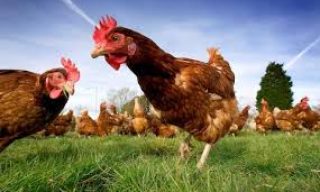
|
Parameter |
Cassava peel level (%) |
||||
| 0.0 | 7.5 | 11.5 | 22.5 | 30.0 | |
| Starter phase | |||||
| Weekly feed intake/bird (g) | 292.3 | 290.1 | 291.8 | 310.1 | 311.6 |
| Weekly weight gain/bird (g) | 132.8a | 130.1a | 129.6ab | 126.3ab | 120.1b |
| Feed intake/ weight gain | 2.2 | 2.2 | 2.3 | 3.5 | 2.6 |
| Mortality (%) | 2.5 | 5.0 | 10.0 | 15.0 | 15.0 |
| Nitrogen retention (%) | 73.1 | 71.2 | 58.3 | 68.2 | 66.7 |
| Protein efficiency ratio | 1.80 | 1.80 | 1.89 | 1.75 | 1.66 |
Feed cost/live weight gain  /kg)a /kg)a |
0.98 | 0.97 | 1.00 | 1.01 | 1.11 |
| Metabolizable energy (kcal/g) | 2.81 | 2.76 | 2.71 | 2.68 | 2.62 |
| Finisher phase | |||||
| Weekly feed intake/bird (g) | 766.5b | 791. lb | 773.6b | 813.2a | 850.7a |
| Weekly weight gain/bird (g) | 218.4a | 219.3a | 206.1ab | 184.3b | 180.1c |
| Feed intake/weight gain | 3.6c | 3.6c | 3.8b | 4.4a | 4.7a |
| Mortality (%) | 0.0 | 5.2 | 8.3 | 8.8 | 8.8 |
| Nitrogen retention (%) | 66.4 | 66.2 | 64.4 | 65.1 | 64.1 |
| Protein efficiency ratio | 1.34a | 1.42a | 1.35a | 1.22b | 1.14b |
Feed cost/live weight gain  /kg)a /kg)a |
1.38 | 1.44 | 1.56 | 1.81 | 1.85 |
| Metabolizable energy (kcal/g) | 2.99 | 2.93 | 2.88 | 2.88 | 2.77 |
Notes: Values in the same row followed by the same letter(s) are not significantly different
(P < 0.05)
a US$1. 0 = Nigerian  2.6 (February 1987)
2.6 (February 1987)
Perhaps feeding cassava peel to cockerels holds the greatest potential. Preliminary studies have so far shown satisfactory performance in finisher cockerels with up to 45 percent inclusion of cassava peel as a replacement for maize in their rations.
Cassava leaves are rich in protein. According to Rogers and Milner (1983) the amount of protein (dry basis) ranges from 17.8 to 34.8 percent in eight Brazilian varieties. Studies in Nigeria by Tewe et al. (1976) also revealed a range of 29.8 to 33.7 percent protein (dry basis) in the leaves of different cassava cultivars. It is important to note that when cassava leaves are sun-cured or dehydrated, all the HCN is liberated and no toxic effects are therefore found when the leaves are consumed by animals. Ross and Enriquez (1969) used up to 20 percent cassava leaf meal in poultry diets and found a decrease in weight gain and feed efficiency when the diet had more than 5 percent cassava leaf meal. When cassava leaf meal was used up to 10 percent, no differences were observed in egg production, feed efficiency and egg weight. However, when 0.15 to 0.30 percent methionine and 3 percent corn oil were added, the results were similar to those from the control diet. Cassava leaf meal has some yellow pigment that gives a good egg yolk pigmentation, and it can be a substitute for all the alfalfa in the diet of laying hens.
Utilization of cassava in swine feeding
Since the pioneering work of Oyenuga and Opeke (1957) and Modebe (1963) in Nigeria, several researchers have confirmed the suitability of cassava for pig feeding and the potential of cassava meal as a good substitute for maize meal for au classes of pigs (Maner 1972; Tewe 1975, 1982; Job 1975; Adegbola 1977; Gomez et al. 1976; and Nghi 1986).
As in the case of poultry, certain precautions need to be taken to guarantee satisfactory performance of stock on cassava meal diets. These include the removal of cyanide through boiling, drying, grating, soaking, fermentation, or a combination of these processes to produce final products containing not more than 100 ppm HCN, and the prevention of microbial activity during sun-drying, particularly in a humid environment. High cyanide levels and the presence of microorganisms have been demonstrated to reduce performance and prevent hematological changes of growing pigs fed on sun-dried cassava-based rations (Tewe 1982, 1984).
The protein deficiency of cassava also demands higher protein supplementation in such rations. Maust et al. (1972) have also demonstrated that cassava can affect mineral balance. resulting in parakeratosis in pigs which can be prevented by including zinc salts in the diet. Dustiness of cassava-based rations can be removed by adding molasses, suitable oils or by pelletizing to make the feed acceptable to pigs.
Table 4. Performance, nutrient utilization, and economy of production in layers fed varying dietary cassava peel levels
|
Parameter |
Cassava peel level (%) |
||||
| 0 | 6.82 | 13.64 | 20.46 | 27.28 | |
| Cost of feed a | |||||
 /t /t |
359.3 | 337.4 | 314.3 | 291.8 | 269.3 |
 /100 eggs /100 eggs |
5.6 | 5.4 | 6.4 | 4.7 | 4.8 |
 /kg eggs /kg eggs |
1.0 | 2.0 | 1.2 | 0.9 | 0.9 |
| Weekly feed consumption/bird (kg) | 0.80b | 0.70c | 0.74d | 0.78b | 0.84a |
| Weekly crude protein intake/bird (kg) | 0.14a | 0.13b | 0.13b | 0.13b | 0.14a |
| Weekly cyanide intake/bird (mg) | 0.00c | 14.74d | 28.32c | 44.78b | 63.92a |
| Average initial body weight (kg) | 1.83 | 1.78 | 1.78 | 1.72 | 1.71 |
| Weekly no. of eggs produced/bird | 5.24a | 4.92c | 5.20a | 5.05 | 4.70c |
| Average weight of egg produced (g) | 54.89c | 55.69b | 52.94d | 53.67d | 56.79a |
| Feed consumption (g/g egg produced) | 2.81c | 2.90b | 2.81c | 2.93b | 3.21a |
| Metabolizable energy (kcal/g) | 3.09a | 3.07a- | 3.05a | 3.09a | 2.75b |
| Nitrogen retention (%) | 58.48a | 47.71a | 47.53ab | 45.48ab | 39.19b |
| Weekly body weight gain (g) | 0.012 | 0.009 | 0.010 | 0.004 | 0.005 |
Notes: Values in the same row followed by the same letter(s) are not significantly different (P < 0.05)
a US$1.0 = Nigerian  2.6 (February 1987)
2.6 (February 1987)
The cost of these feed supplementations need to be compared with those for maize in practical swine feeding. It is noteworthy that the EEC imports cassava chips from Thailand for incorporation at up to 40 percent into swine rations. Growing pigs fed on a diet containing 40 percent cassava peel and discarded small tubers have been observed to perform satisfactorily (Tewe and Oke 1983, Tewe at al. 1987). Indeed, pigs fed on such rations produced leaner carcasses and showed an economy of feed conversion as shown in table 5.
Apart from dried cassava, pigs can also be fed with fresh cassava tuberous roots, as is commonly practiced in small- and medium-scale pig farming enterprises in Nigeria. Such pig farmers usually depend on the cassava grown on their farm or sometimes supplement their cassava supplies with those purchased from neighboring farmers. Chopped cassava tuberous roots, either fresh or parboiled, are fed to the pigs but the death of many young pigs has been reported, caused by cyanide toxicity in fresh cassava tuberous roots. To overcome this problem, some of the farmers now sun-dry the grated cassava tuberous roots, with or without fermentation, before feeding them to pigs.
In yet another group of farmers, the cassava peel together with discarded unwholesome tubers are chopped, sun-dried and mixed with concentrates to feed pigs. Therefore, inspite of considerable research efforts in Nigeria to formulate appropriate diets for feeding pigs, there has not been a uniform method for utilizing cassava as feed to meet the specific nutrient requirements of pigs at different ages and phases of commercial pig production.
Table 5. Cassava peel in growing pig rations: effects on performance, carcass characteristics and economy of production
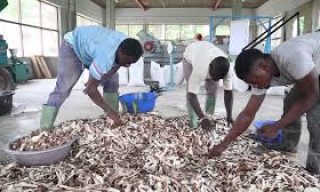
|
Experiment I: Cassava peel level (%) |
Experiment II: Cassava peel level (%) |
|||||
| Parameter | 0 | 10 | 20 | 30 | 0 | 40 |
| Daily weight gain (kg) | 0.41 | 0.38 | 0.39 | 0.40 | 0.49 | 0.53 |
| Daily feed intake (kg) | 1.45 | 1.45 | 1.46 | 1.60 | 1.35 | 1.31 |
| Feed/gain | 3.79b | 3.79ab | 3.69ab | 3.96a | 2.81 | 2.48 |
| Dressing percentage | 74.1 | 69.8 | 73.1 | 70.3 | 81.9 | 81.7 |
| Percentage lean cut | 64.52 | 55.42 | 66.94 | 64.84 | 66.9 | 64.5 |
| Percent trimmed fat | 10.69a | 10.44a | 9.29b | 9.63ab | 16.0 | 16.6 |
Gross gain/feed cost  a a |
132.5 | 129.2 | 149.2 | 145.7 | 162.0 | 191.0 |
Source: Experiment I: Tewe and Oke (1983); Experiment II: Tewe et al. (1986)
Notes: Means without common letter(s) on horizontal rows are significantly different (P < 0.05)
a US$ 1.0= 2.6 (February 1987)
2.6 (February 1987)
Future perspective
The use of cassava in commercial pig and poultry feeding in Nigeria has been limited by many factors. The conservative attitude of feed millers to the use of locally available alternatives is now changing gradually. However, there is a lack of proper technology to produce cassava products of guaranteed quality that will meet the nutritional needs of these fast growing monogastric livestock for satisfactory productivity in commercial farms. There is need to obtain products with well defined standards in the following:
· Nutrient levels: energy, protein, fibre and mineral levels;
· Levels of anti-nutritional factors: hydrocyanic acid, phytates and oxalates;
· Microbial counts: levels of Aspergillus and Eschericia species;
· Levels of other contaminants: those introduced during the drying process;
· Moisture contents.
High moisture levels predispose cassava products to spoilage during processing, therefore, the construction of drying facilities that can be utilized in rural areas should be considered so that the processing can be carried out near farm sites. During the dry season, cassava can also be sun-dried.
Another mayor constraint is the economics of feed production when cassava tuberous roots are incorporated into finished livestock feeds. At present, one ton of cassava tuberous roots costs about  500 in the open market, giving an estimate of one ton of dry cassava flour at about
500 in the open market, giving an estimate of one ton of dry cassava flour at about  1500 (US$1.0 =
1500 (US$1.0 =  2.6, 1987). Dried cassava contains about 7% crude protein compared to 10% in maize, therefore an additional 80 kg of protein must be added from a protein concentrate such as groundnut cake or soybean meal to produce a suitable feed. This will cost an additional
2.6, 1987). Dried cassava contains about 7% crude protein compared to 10% in maize, therefore an additional 80 kg of protein must be added from a protein concentrate such as groundnut cake or soybean meal to produce a suitable feed. This will cost an additional  240. The present cost of maize is about
240. The present cost of maize is about  1500 per ton, therefore, cassava does not appear to be an economically attractive substitute for maize. To reduce the cost of cassava products, cassava leaf meal can be incorporated instead of the more expensive oil seed cakes to increase the protein content of the feed. However, one sure way to encourage the use of cassava tuberous roots in livestock feeding is to exploit its agronomic potential which can ensure the production of cassava tuberous roots in excess of the needs for human food so that the extra tubers can be used along with cassava peel and leaves to reduce the cost of finished commercial poultry and pig rations.
1500 per ton, therefore, cassava does not appear to be an economically attractive substitute for maize. To reduce the cost of cassava products, cassava leaf meal can be incorporated instead of the more expensive oil seed cakes to increase the protein content of the feed. However, one sure way to encourage the use of cassava tuberous roots in livestock feeding is to exploit its agronomic potential which can ensure the production of cassava tuberous roots in excess of the needs for human food so that the extra tubers can be used along with cassava peel and leaves to reduce the cost of finished commercial poultry and pig rations.

